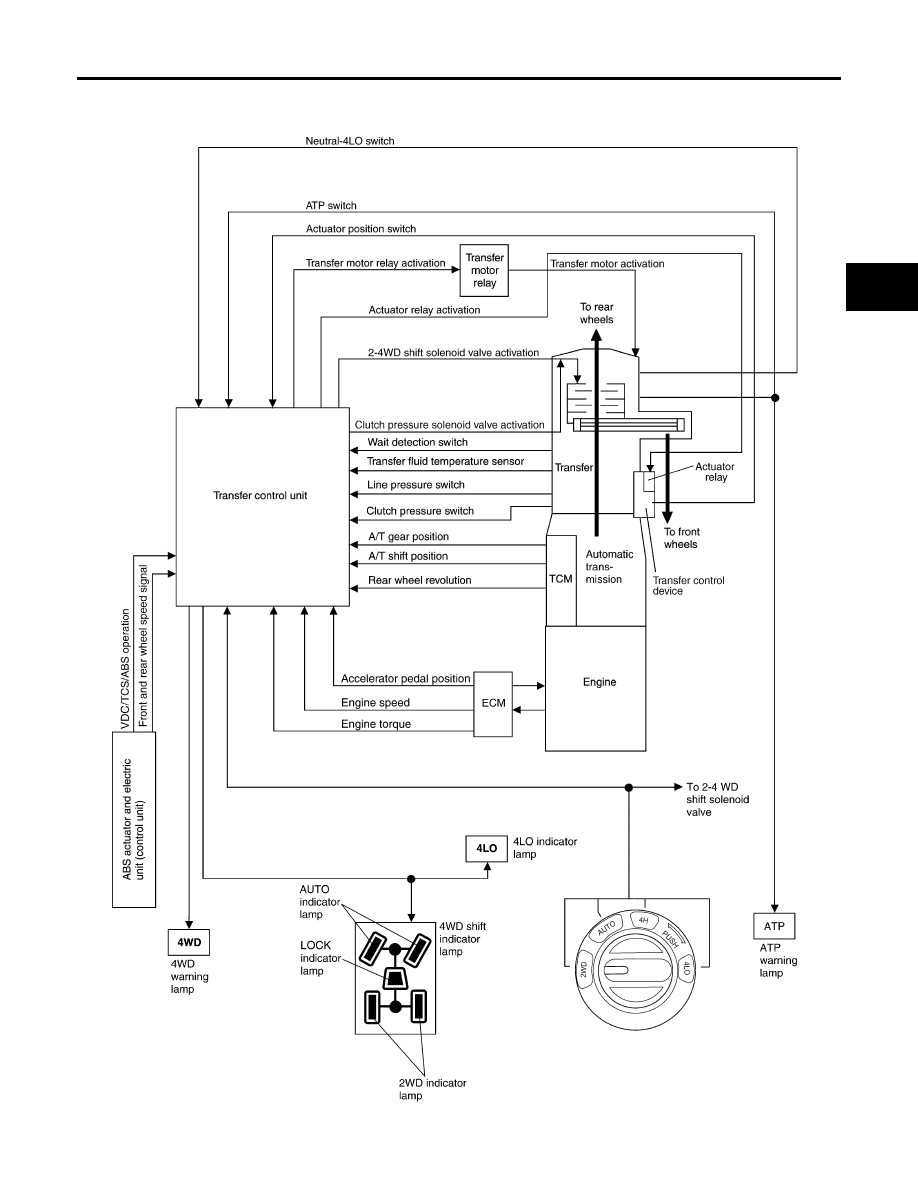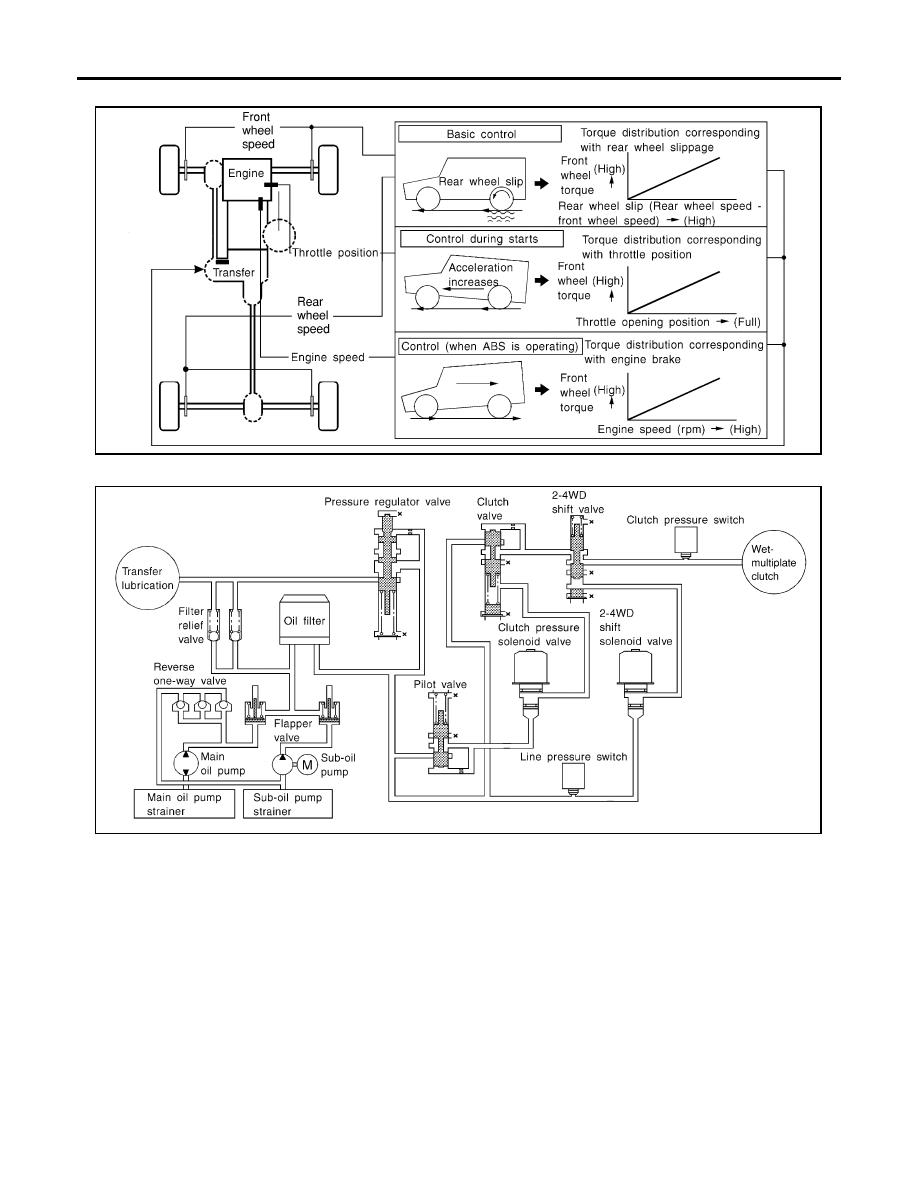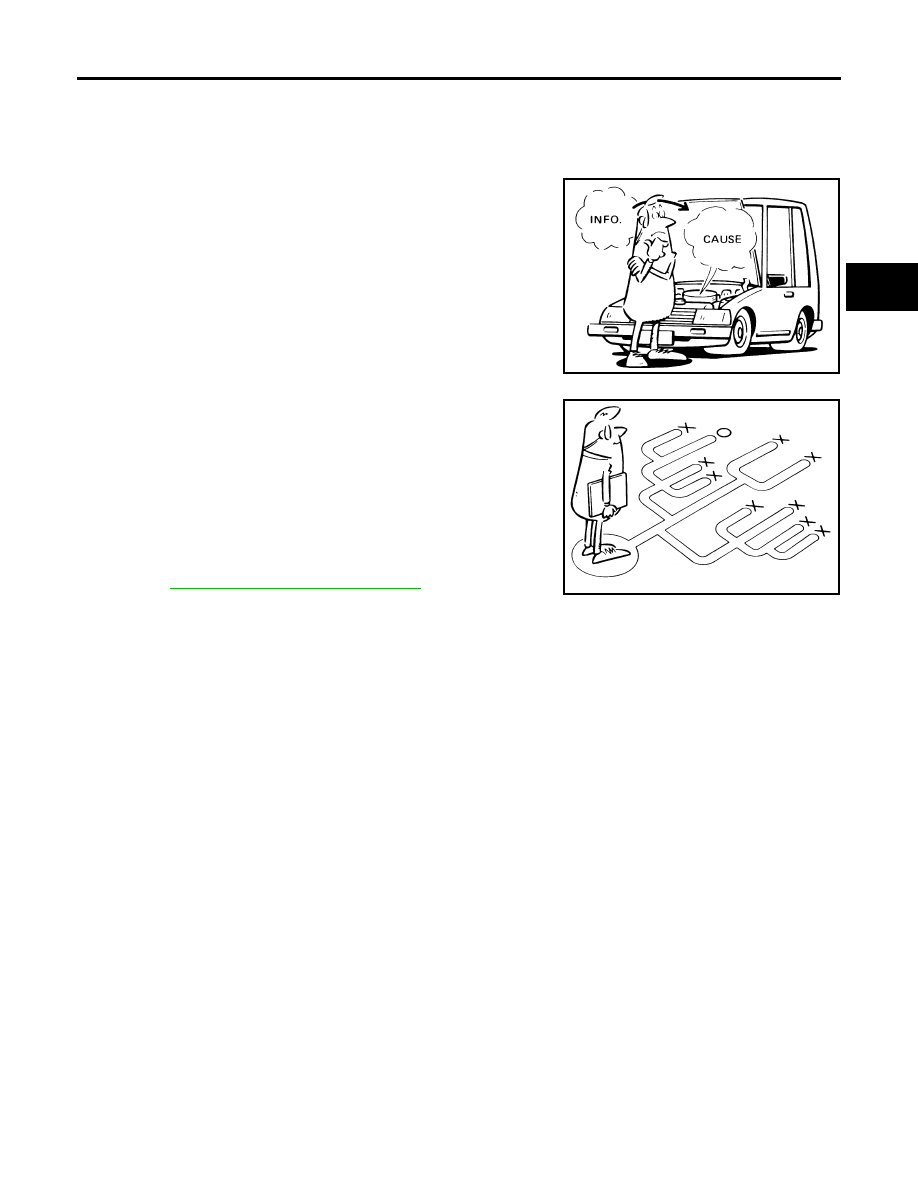Where Is the Low Presser Swich on a 2007 Nissan Pathfinder
Content .. 390 391 392 393 ..
Nissan Pathfinder (2007 year). Manual - part 392

ALL-MODE 4WD SYSTEM
TF-17
[ATX14B]
C
E
F
G
H
I
J
K
L
M
A
B
TF
2007 Pathfinder
System Description
EDS00362
CONTROL SYSTEM
SDIA3396E

TF-18
[ATX14B]
ALL-MODE 4WD SYSTEM
2007 Pathfinder
ALL-MODE 4WD Transfer Basic Control
Hydraulic Control Circuits
TRANSFER MOTOR
●
The transfer motor drives the sub-oil pump to provide proper lubrication and oil pressure control when the
vehicle is at standstill, during low-speed operations or is being driven in reverse.
●
The main oil pump is operated by the driving force of the mainshaft. In other words, sufficient oil pressure
buildup does not occur when the vehicle is at standstill or during low-speed operations. While the vehicle
is being driven in reverse, the main oil pump rotates in the reverse direction. Therefore the main oil pump
does not discharge oil pressure. During any of the above vehicle operations, the transfer motor drives the
sub-oil pump to compensate for insufficient oil pressure.
●
The transfer motor operates as follows.
–
The motor relay turns OFF in the 2WD mode.
–
The motor relay operates as described in the table below in modes other than the 2WD mode.
●
4WD shift switch, PNP switch, Neutral-4LO switch, vehicle speed sensor and throttle position sensor are
used in conjunction with the transfer motor.
LDIA0055E
WDIA0163E

ALL-MODE 4WD SYSTEM
TF-19
[ATX14B]
C
E
F
G
H
I
J
K
L
M
A
B
TF
2007 Pathfinder
Transfer Motor Relay Operation
*: After 2.5 seconds have elapsed.
WAIT DETECTION SWITCH
●
The wait detection switch operates when there is "circulating" torque produced in the propeller shaft
(L
→
H) or when there is a phase difference between 2-4 sleeve and clutch drum (H
→
L). After the release
of the "circulating" torque, the wait detection switch helps provide the 4WD lock gear (clutch drum) shifts.
A difference may occur between the operation of the 4WD shift switch and actual drive mode. At this
point, the wait detection switch senses an actual drive mode.
●
The wait detection switch operates as follows.
–
4WD lock gear (clutch drum) locked: ON
–
4WD lock gear (clutch drum) released: OFF
●
The wait detection switch senses an actual drive mode and the 4WD shift indicator lamp indicates the
vehicle drive mode.
NEUTRAL-4LO SWITCH
The neutral-4LO switch detects that transfer gear is in neutral or 4LO (or shifting from neutral to 4LO) condi-
tion by L-H shift fork position.
ATP SWITCH
The ATP switch detects that transfer gear is under neutral condition by L-H shift fork position.
NOTE:
Transfer gear may be under neutral condition in 4H-4LO.
2-4WD SHIFT SOLENOID VALVE
The 2-4WD shift solenoid valve operates to apply oil pressure to the wet-multiplate clutch, depending on the
drive mode. The driving force is transmitted to the front wheels through the clutch so the vehicle is set in the
4WD mode. Setting the vehicle in the 2WD mode requires no pressure buildup. In other words, pressure force
applied to the wet-multiplate clutch becomes zero.
4WD shift switch
A/T selector lever position
Vehicle speed
(VSS)
Accelerator pedal position
Motor relay drive
command
2WD
—
—
—
OFF
4H (LOCK) and 4LO
"N" position
0
—
ON
"P" position
0
0 - 0.07/8
OFF*
0.07/8 - 1/8
HOLD
1/8 - MAX
ON
Other than "R" position
0 < VSS
≤
50 km/h (31 MPH)
—
ON
50 km/h (31 MPH) < VSS <
55 km/h (34 MPH)
HOLD
55 km/h (34 MPH)
≤
VSS
OFF
"R" position
—
—
ON
"R" position
—
—
ON
AUTO
"P" or "N" position
0
0 - 0.07/8
OFF*
0.07/8 - 1/8
HOLD
1/8 - MAX
ON
0 < VSS
≤
50 km/h (31 MPH)
—
ON
50 km/h (31 MPH) < VSS <
55 km/h (34 MPH)
HOLD
55 km/h (34 MPH)
≤
VSS
OFF
Other than "R", "P" and "N"
position
0 < VSS
≤
50 km/h (31 MPH)
—
ON
50 km/h (31 MPH) < VSS <
55 km/h (34 MPH)
HOLD
55 km/h (34 MPH)
≤
VSS
OFF
TF-20
[ATX14B]
ALL-MODE 4WD SYSTEM
2007 Pathfinder
CLUTCH PRESSURE SOLENOID VALVE
The clutch pressure solenoid valve distributes front and rear torque in AUTO mode.
LINE PRESSURE SWITCH
●
With the transfer system design, control of the oil pressure provides the transmission of drive torque to the
front wheels. The main pressure to control the oil pressure is referred to as the line pressure.
●
The line pressure switch determines whether or not adequate line pressure has built up under different
operating conditions.
●
The line pressure switch closes when line pressure is produced.
●
The line pressure switch senses line pressure abnormalities and turns the 4WD warning lamp ON.
CLUTCH PRESSURE SWITCH
●
The clutch pressure switch determines whether or not adequate clutch pressure has built up under differ-
ent operating conditions.
●
The clutch pressure switch closes when clutch pressure is produced.
●
The clutch pressure switch senses clutch pressure abnormalities and turns the 4WD warning lamp ON.
TRANSFER FLUID TEMPERATURE SENSOR
The transfer fluid temperature sensor detects the transfer fluid temperature and sends a signal to the transfer
control unit.
TRANSFER CONTROL UNIT
●
Transfer control unit controls transfer control device by input signals of each sensor and each switch.
●
Self-diagnosis can be done.
TRANSFER CONTROL DEVICE
The transfer control device changes the state of transfer assembly between 2WD, AUTO, 4H
⇔
4LO with the
2WD, AUTO, 4H and 4LO signals of 4WD shift switch.
NOTE:
●
To shift between 4H
⇔
4LO, stop the vehicle, depress the brake pedal and shift the transmission selector
to the "N" position. Depress and turn the 4WD shift switch. The shift switch will not shift to the desired
mode if the transmission is not in "N" or the vehicle is moving. The 4LO indicator lamp will be lit when the
4LO is engaged.
●
Actuator motor and actuator position switch are integrated.
4WD SHIFT SWITCH AND INDICATOR LAMPS
4WD Shift Switch
Able to select from 2WD, AUTO, 4H or 4LO.
4WD Shift Indicator Lamp
●
Displays driving conditions selected by 4WD shift switch with 2WD, AUTO and 4H indicators while engine
is running. (When 4WD warning lamp is turned on, all 4WD shift indicator lamps are turned off.)
●
Turns ON for approximately 1 second when ignition switch is turned ON, for purpose of lamp check.
4LO Indicator Lamp
●
Displays 4LO condition while engine is running. 4LO indicator lamp flashes if transfer gear does not shift
completely under 2WD, AUTO, 4H
⇔
4LO. (When 4WD warning lamp is turned on, 4LO indicator lamp is
turned off.)
●
Turns ON for approximately 1 second when ignition switch is turned ON, for purpose of lamp check.

ALL-MODE 4WD SYSTEM
TF-21
[ATX14B]
C
E
F
G
H
I
J
K
L
M
A
B
TF
2007 Pathfinder
4WD WARNING LAMP
●
Turns ON or flashes when there is a malfunction in 4WD system.
●
Turns ON when ignition switch is turned ON, for purpose of lamp check. Turns OFF approximately for 1
second after the engine starts if system is normal.
4WD Warning Lamp Indication
*: When 4WD warning lamp is ON, all the 4WD shift indicator lamps turn OFF.
ATP WARNING LAMP
Even if A/T selector lever is in "P" position, vehicle may move because A/T parking mechanism does not oper-
ate when transfer is under neutral condition. ATP warning lamp is turned on to indicate this condition to the
driver.
System Diagram
EDS00363
Condition
Content
4WD warning lamp
During self-diagnosis
Indicates the malfunction position by number of flickers.
Flickers at malfunction mode.
Lamp check*
Checks the lamp by turning ON during engine starting. After
engine starts, it turns OFF if there are no malfunctions.
ON
Malfunction in 4WD system*
Turns ON to indicate malfunction. When ignition switch is
turned to "OFF" or the malfunction is corrected, it turns OFF.
ON
When vehicle is driven with different
diameters of front and rear tires
Flickers slowly (once every 2 seconds).
Turns OFF when ignition switch is "OFF".
Flickers once every 2 sec-
onds.
High fluid temperature in transfer unit
Flickers rapidly (twice every second) when fluid temperature
is high or fluid temperature sensor circuit is shorted.
It turns OFF when fluid temperature becomes normal.
Flickers twice a second.
Other than above (System is nor-
mal.)
Lamp is OFF.
OFF
WDIA0164E

TF-22
[ATX14B]
ALL-MODE 4WD SYSTEM
2007 Pathfinder
COMPONENTS FUNCTION
CAN Communication
EDS00364
SYSTEM DESCRIPTION
Refer to
LAN-4, "SYSTEM DESCRIPTION"
.
Component parts
Function
Transfer control unit
Controls transfer control device and control valves.
Transfer control device
Actuator motor and actuator position switch are integrated so as to switch driving types.
2-4WD shift solenoid valve
Controls oil pressure and allows selection between 2WD and 4WD.
Clutch pressure solenoid valve
Controls oil pressure and distributes torque (front and rear).
Line pressure switch
Detects line pressure.
Clutch pressure switch
Detects clutch pressure.
Transfer fluid temperature sen-
sor
Detects transfer fluid temperature.
Wait detection switch
Detects whether or not 4WD lock gear is locked.
Neutral-4LO switch
Detects that transfer is under neutral-4LO condition (or shifting through neutral).
ATP switch
Detects that transfer is under neutral condition.
4WD shift switch
Allows selection from 2WD, AUTO, 4H or 4LO.
4WD warning lamp
●
Illuminates if malfunction is detected in electrical system of 4WD system.
●
There is 1 blink every 2 seconds if rotation difference of front wheels and rear wheels is large.
●
There is 2 blinks every 1 second if high transfer fluid temperature is detected.
ATP warning lamp
Indicates that A/T parking mechanism does not operate when A/T selector lever is in "P" position
and transfer is under neutral condition.
4WD shift indicator lamp
Displays driving condition selected by 4WD shift switch.
4LO indicator lamp
Displays 4LO condition.
ABS actuator and electric unit
(control unit)
Transmits vehicle speed signal via CAN communication to transfer control unit.
TCM
Transmits the following signals via CAN communication to transfer control unit.
●
Output shaft revolution signal
●
A/T position indicator signal (PNP switch signal)
ECM
Transmits the following signals via CAN communication to transfer control unit.
●
Engine speed signal
●
Accelerator pedal position signal

TROUBLE DIAGNOSIS
TF-23
[ATX14B]
C
E
F
G
H
I
J
K
L
M
A
B
TF
2007 Pathfinder
TROUBLE DIAGNOSIS
PFP:00004
How to Perform Trouble Diagnosis
EDS00365
BASIC CONCEPT
●
To perform trouble diagnosis, it is important to have a through understanding about vehicle systems.
●
It is also important to clarify customer complaints before inspec-
tion. First of all, reproduce symptoms, and understand them
fully. Ask customer about his/her complaints carefully. In some
cases, it will be necessary to check symptoms by driving vehicle
with customer.
CAUTION:
Customers are not professional. It is dangerous to make an
easy guess like "maybe the customer means that...," or
"maybe the customer mentions this symptom".
●
It is essential to check symptoms right from the beginning in
order to repair malfunctions completely. For intermittent mal-
functions, reproduce symptoms based on interview with cus-
tomer and past examples. Do not perform inspection on ad hoc
basis. Most intermittent malfunctions are caused by poor con-
tacts. In this case, it will be effective to shake suspected harness
or connector by hand. When repairing without any symptom
diagnosis, you cannot judge if malfunctions have actually been
eliminated.
●
After completing diagnosis, always erase diagnostic memory.
Refer to
TF-55, "ERASE SELF-DIAGNOSIS"
.
●
For intermittent malfunctions, move harness or harness connec-
tor by hand. Then check for poor contact or reproduced open circuit.
SEF233G
SEF234G

TF-24
[ATX14B]
TROUBLE DIAGNOSIS
2007 Pathfinder
Location of Electrical Parts
EDS00366
WDIA0124E
Content .. 390 391 392 393 ..
Where Is the Low Presser Swich on a 2007 Nissan Pathfinder
Source: https://zinref.ru/avtomobili/Nissan/041_03_Nissan_Pathfinder_2007_EN_4600_raznie_2/392.htm
0 Response to "Where Is the Low Presser Swich on a 2007 Nissan Pathfinder"
Post a Comment